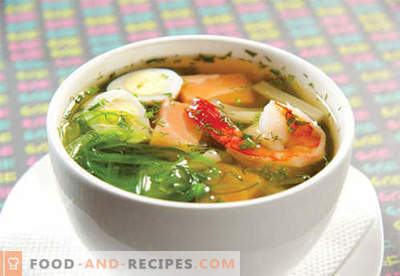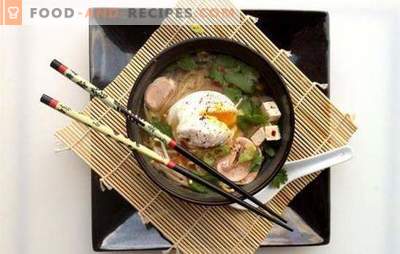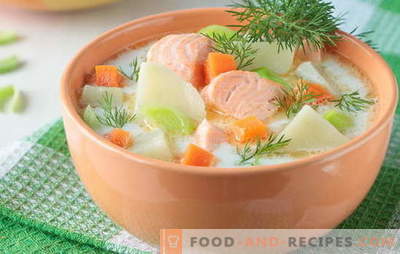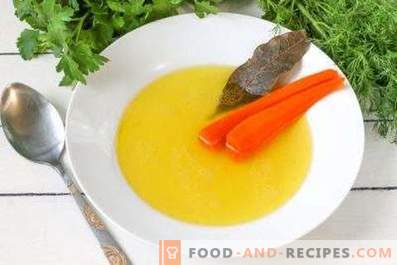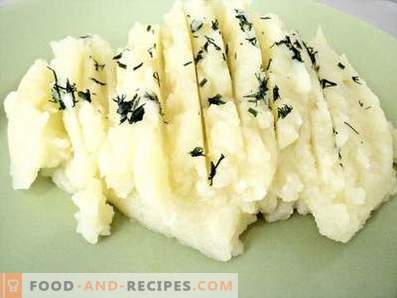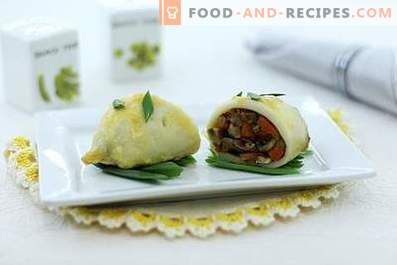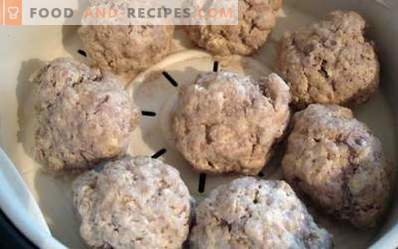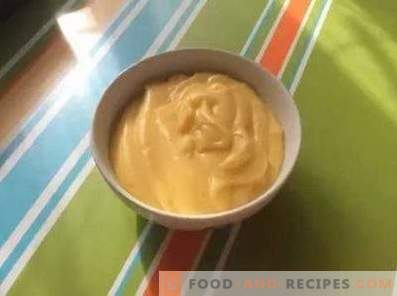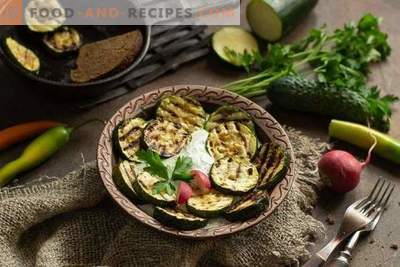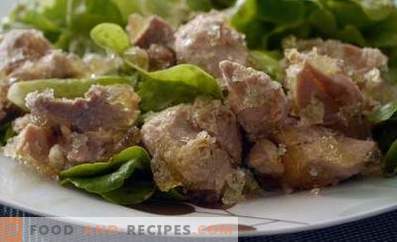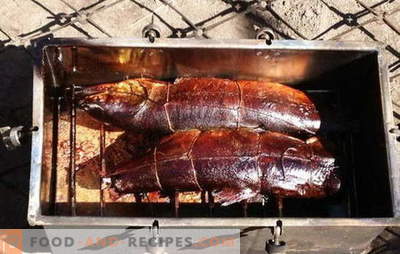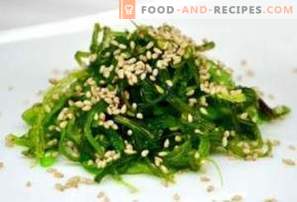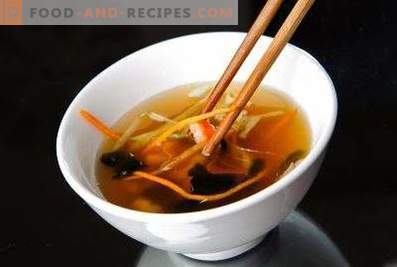
First courses in Japanese cuisine play a big role. They are prepared in every family and can be consumed several times during the day. Japanese soups are divided into two categories: thick and transparent. The transparent are called “suimono”, which in Japanese means “that which they drink”. That is why many of our compatriots call soups of this category broths. Suimono broth is most often made from seaweed and tuna chips with the addition of seafood. The liquid base of such soups is called dashi broth (or dashi). A distinctive feature of Suimono is the absence of soy paste in the composition, tofu is also almost never added to such soups. Algae, shrimps and other seafood make them more satisfying.
Cooking Features
The process of cooking Suimono broth is not very complex, but Japanese cuisine is not so familiar to our compatriots to leave the technology of cooking clear Japanese soup without further explanation.
- If you want to cook at home a Swimono soup that is identical to the original, you have to spend time and money collecting the right ingredients. If you're lucky, you will find everything you need for making Suimono broth in the hypermarket on the shelves where there are sushi products. Seafood you can buy in another department of the store.
- The recipe for Suimono broth can be adapted to the realities of Russian life by boiling it from some seaweed or even from daikon. Another option is to take as a basis not dashi, but any fish broth. A set of fish delicacies listed in the recipe can also be adjusted to suit the products that you have in the fridge.
- Suimono soup can be cooked not only with seafood, but also with mushrooms, if the combination of fish broth and mushrooms does not seem frightening to you. When choosing a supplement in the form of mushrooms, the liquid base can be made without adding fish, from algae or daikon alone.
They serve Souimo soup in small clay cups, shaped like a bowl. After all, this broth can not only eat, but also to drink.
Seafood Suimono Broth
Composition:
- Daikon - 150 g;
- Kombu seaweed - 20 g;
- Wakame seaweed - 20 g;
- tuna chips - 20 g;
- dry noodles - 60 g;
- shiitake mushrooms (dried) - 20 g;
- baby octopuses - 0, 3 kg;
- hondashi powder - 20 g;
- Mirin - 10 g;
- water - 1 l;
- soy sauce, green onions - to taste.
Method of preparation:
- Daikon wash, cut into small pieces.
- Boil water, dip daikon in it, boil for 10 minutes.
- Remove the pan from the heat, strain the broth.
- Dissolve hondashi powder in hot broth, add tuna chips and kombu seaweed.
- Cover the pot with a lid, leave the food to infuse for 15-20 minutes.
- Strain the broth again. Do not hurry to throw away the algae and tuna shavings - they can be used again, simply by increasing the decoction time by 2 times.
- Wash octopuses by removing spikes.
- Boil the prepared liquid base, dip octopuses in it, boil them for 2-3 minutes. Add the mushrooms and noodles, continue cooking the same amount.
- Pour the mirin and soy sauce, cook the soup for another two or three minutes and remove from the heat.
- Spread the wakame seaweed on the bowls, pour the cooked soup.
It remains to sprinkle the soup with finely chopped green onions and serve to the table. Try not to offend anyone and put approximately the same number of octopuses on each plate.
Simple recipe for Suimono broth
Composition:
- sea kale (dried) - 150 g;
- water - 1 l;
- lime - 1 pc .;
- leek (bottom) - 100 g;
- soy sauce - to taste;
- sake - 5 ml.
Method of preparation:
- Sea cabbage fill with water, leave for an hour.
- Put on medium heat, bring to a boil and cook for 5-7 minutes.
- Strain broth, cool.
- Cut the onion and lime into thin pieces, cover with broth.
- Heat the broth again. When it boils, add sake and soy sauce to it, boil for 3-4 minutes.
- Strain.
Ready-made Suimono broth can be poured into cups or bowls and served to the table. It is also used to make clear Japanese soups with mushrooms or seafood.
Souimono soup in fish broth
Composition:
- trimming salmon - 0, 2 kg;
- shrimp cooked and frozen peeled - 0, 2 kg;
- water (for broth) - 1 l;
- carrots - 100 g;
- lime - 4 slices;
- Wakame seaweed - 20 g;
- soy sauce - to taste.
Method of preparation:
- Pour water over the pieces of salmon, bring to a boil over medium heat. Cook for 5 minutes, removing the foam, reduce the heat and cook on low heat for 30-40 minutes. Strain the finished broth.
- Peel the carrots and grate them on a grate for preparing Korean salads. If you do not have such a device, you can simply chop the vegetable into thin strips.
- Place the carrots in a frying pan, cover with clean water and stew until soft, fold in a colander.
- In a clean pan, boil a new portion of water, dip the thawed shrimps in it, cook for 5 minutes and remove with a slotted spoon.
- Spread the shrimps, algae and carrots into plates without stirring.
- Boil fish broth, add soy sauce, cook for a couple of minutes.
- Pour the prepared ingredients into the fish broth.
When serving, decorate the soup with lime slices. It will give the dish not only an even more appetizing look, but also a pleasant aroma. This recipe is suimono adapted to Russian cuisine, it will appeal even to those who are not supporters of Asian dishes.
Suimono recipe with vegetables and champignons
Composition:
- water or fish broth - 1, 5 l;
- boiled-frozen shrimps (unpeeled) - 0.5 kg;
- squid - 0, 4 kg;
- fresh champignons - 150 g;
- carrots - 100 g;
- potatoes - 0, 2 kg;
- cauliflower (optional) - 100 g;
- onions - 100 g;
- salt, pepper - to taste.
Method of preparation:
- Clean and wash the carcasses of squid, lower them for a few minutes in boiling water, cool and cut them into strips.
- Boil shrimp in salted water. Cool, clean them.
- Cut the mushrooms.
- Wash and peel vegetables, cut into small cubes.
- Boil fish broth, put mushrooms and vegetables in it, add salt and season to taste, cook for 15-20 minutes (until ready).
- Spoon the seafood, pour the soup.
The soup prepared according to this recipe resembles the original suimono only distantly, but many people unfamiliar with Japanese cuisine should better get used to it with such adapted versions of dishes.
Suimono broth - one of the wealth of Japanese cuisine. This category includes transparent soups, which are often prepared with the addition of seafood. People who are not used to Asian cuisine will like the adapted versions of this dish.

